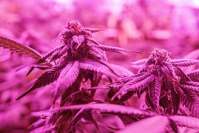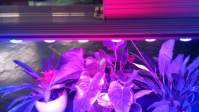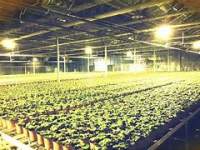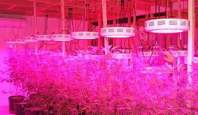The effect of LED seedling plant growth light on spinach and other plants
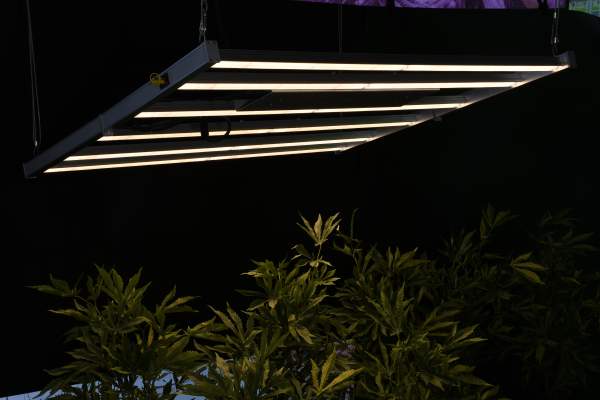
When using led plant growth lights for plant planting, the height from the leaves is generally about 30-50 cm. In this process, different light intensities need to be given according to the types of plants to be planted. Adjusting the height is generally regarded as the easiest way to adjust the brightness.
Color temperature and lumens of LED biological light source
The color temperature and lumens of artificial light sources can be seen by the eyes of living beings, while the demand for light of plants is photosynthesis, which is determined by the radiant value without looking at the color temperature and lumens.
The effect of spectral range on plant physiology
80 ~ 315nm ---> This wavelength is already ultraviolet light. It has the effect of directly suppressing the growth of various animals, plants and even fungi, and has a very small impact on morphology and physiological processes.
315 ~ 400nm ---> This kind of light is also a far-ultraviolet light. Although it does not harm plants, it has no direct effect on plant growth. The absorption of chlorophyll is low, which affects the photoperiod effect and prevents the elongation of stems.
400 ~ 520nm (blue) -> These wavelengths can directly develop the roots and stems of plants, have the largest absorption ratio of chlorophyll and carotenoids, and have the greatest impact on photosynthesis.
520 ~ 610nm (green) -> Green plants are repulsively pushed, and the absorption rate of green pigment is not very high.
610 ~ 720nm (red) -> The chlorophyll absorption rate of plants is not high, but this wavelength has a significant effect on photosynthesis and plant growth speed.
720 ~ 1000nm ---> These wavelengths are generally infrared wavelengths, which have low absorption rate for plants, can directly stimulate cell elongation, and will affect flowering and seed germination.
>1000nm ---> The wavelength of the laser light has been approached and converted into heat.
Looking at the above plant and spectral data, each wavelength of light has a different effect on plant photosynthesis. Among the light that plants need for photosynthesis, 400 ~ 520nm (blue) light, and 610 ~ 720nm (red ) Contributes the most to photosynthesis, and 520 ~ 610nm (green) light has a very low rate of effect on the growth of plants.
In terms of visual effects, the red and blue LED plant growth lamp is pink. This mixed light color is really uncomfortable for biological lighting. However, it can only be used to observe the appearance with practicality to choose Its practicality is mainly.
Generally white LED lamp beads, the most common is to use a blue core to stimulate the yellow phosphor to emit light, thereby producing a composite visual white light effect. In the energy distribution on the integrating sphere test report, there are two peaks in the blue area of 445nm and the yellow-green area of 550nm.
The 610 ~ 720nm red light required by plants covers a relatively small area and cannot supply the light and light efficiency required for the plants to be grown. This explains why the growth rate and harvesting effect of plants under the illumination of white LEDs are not as good as those of ordinary outdoor planting.
Using the above data, the chromatogram ratio of red and blue lights of plant lights is generally between 5:1 and 10:1. Usually, the ratio of 7-9:1 can be selected. Only the ratio distribution requires the brightness ratio of the lamp beads. It is the basis for light mixing, and the number of non-lighting beads is the basis for light mixing.
If according to the above principles, plants are only for 400 ~ 520nm (blue) and 610 ~ 720nm (red), the spectrum has the effect of directly helping the growth, so the led plant lights under the academic concept are made into a combination of red and blue, all blue, The three forms of full red can provide light with two wavelengths of red and blue to cover the wavelength range required for photosynthesis of plants.
Due to the use of greenhouse seedlings and LED plant lights for supplementary light, the yield is stable, the cycle is controllable, and the lights are free from pests and diseases. In Taiwan and Japan, greenhouse seedlings have become a trend. At present, there are also some scientific research institutions in China that are experimenting with LED nursery plant lights.
1. LED light source can significantly promote the growth and development of spinach, radish and lettuce, and improve morphological indicators; vinegar can maximize the bioaccumulation of sugar beet.
2. Betanin accumulation in the hair roots is the most significant, and the sugar and starch accumulation in the hair roots increases.
3. Light with a specific wavelength can affect the flowering time, quality and duration of flowering of plants.
Fourth, it can increase the number of flower buds and the number of flowering of plants.
5. It can reduce the flower formation response, regulate the length of the pedicel growth and prolong the flowering period.
6. there are many types of wavelengths, which coincide with the range of plant photosynthesis, photomorphogenesis, and spectrum.


